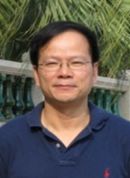Recent Events
- Wei Mo & Jiahuai Han: Gut stem c...
- Qiao Wu: Ectosomal PKM2 Promotes...
- Jing Yuan: A Protein Palmitoylat...
- Zhenghong Zuo: Black Phosphorus ...
- Jing Yuan: An intracellular memb...
- Qinxi Lin: c-Src Promotes Tumori...
- Shengcai Lin: AMPK and TOR: the ...
- Chundong Yu: Inflammation-induce...
- Shengcai Lin: Glucose Starvation...
- Xi Huang: Coordinated Transcript...
Shengcai LIN, Ph.D. Professor. Tel:+86-592-2182993 E-mail: linsc@xmu.edu.cn Labsite:http://www.linlab.icoc.in/ |
|
Education
1984, B.Sc. Xiamen University;
1991, Ph.D., UTSouthwestern Medical Center at Dallas.
Professional Experience
1991-1995, Postdoctoral Fellow at the Howard Hughes Medical Institute, UCSD;
1995-2001, Principal Investigator, IMCB, Singapore;
2001-2006, Assistant Professor/Associate Professor (tenured), Hong Kong University of Science and Technology;
2003-Present, Dean, School of Life Sciences, Xiamen University;
2001-Present, Professor, Cheung Kong Scholar, Xiamen University.
Research Area
Our research lies in the broad area of the molecular mechanisms that underlie metabolic homeostasis and its relationship to cell growth control. We have discovered a signaling pathway comprising the protein kinase GSK3, acetyltransferase TIP60, and protein kinase ULK1, which activates autophagy in cells deprived of serum, elucidating the molecular mechanism linking nutritional starvation to autophagy. More recently, we have that the low-energy signal AMP can autonomously initiate assembly of an activating complex for the energy sensor kinase AMPK. Current interests include further exploration of how AMPK is regulated at the molecular biology, subcellular organelle, and organismal levels, and study of how the autophagy cross-talks to the overall metabolic control or reprogramming. Our ultimate goal is to reveal a unifying mechanism that governs metabolic homeostasis in response to metabolic stresses, and the metabolic checkpoint for cell growth.
Selected Publications
1. Li TY, Sun Y, Liang Y, Liu Q, Shi Y, Zhang CS, Zhang C, Song L, Zhang P, Zhang X, Li X, Chen T, Huang HY, He X, Wang Y, Wu YQ,Chen S, Jiang M, Chen C, Xie C, Yang JY, Lin Y, Zhao S, Ye Z, Lin SY, Chiu DT,Lin SC. ULK1/2 Constitute a Bifurcate Node Controlling Glucose Metabolic Fluxes in Addition to Autophagy. Mol Cell. 62(3): 359-70, 2016.
2. Zhang CS,Lin SC. AMPK Promotes Autophagy by Facilitating Mitochondrial Fission.Cell Metab. 23(3): 399-401, 2016.
3. Zhang CS, Liu Q, Li M, Lin SY, Peng Y, Wu D, Li TY, Fu Q, Jia W, Wang X, Ma T, Zong Y, Cui J, Pu C, Lian G, Guo H, Ye Z,Lin SC. RHOBTB3 promotes proteasomal degradation of HIFα through facilitating hydroxylation and suppresses the Warburg effect.Cell Res. 25(9): 1025-42, 2015.
4. Feng Y, Li X, Ray L, Song H, Qu J,Lin S, Lin X. The Drosophila tankyrase regulates Wg signaling depending on the concentration of Daxin.Cell Signal. 26(8): 1717-24, 2014.
5. Zhang CS, Jiang B,Li MQ, Zhu MJ, Peng YY, Zhang YL, Wu YQ, Li TY, Liang Y, Lu ZL, Lian GL, Liu Q, Guo HL,Yin ZY, Ye ZY, Han J, Wu JW, Yin HY, Lin SY,Lin SC*. The lysosomal v-ATPase-ragulator complex is a common activator for AMPK and mTORC1, Acting as a switch between catabolism and anabolism.CellMetabolism. 20, 526-540, 2014.
6. Zhang YL, Guo HL, Zhang CS, Lin SY, Li P, WU JW, andLin SC*.AMP as a low energycharge signal autonomously initiates assembly of AXIN-AMPK-LKB1 complex for AMPK activation.Cell Metabolism. 18:546–555, 2013.
7. Lin SY, Li TY, Liu Q, Zhang C, Li X, Chen Y, Zhang SM, Lian G, Liu Q, Ruan K, Wang Z, Zhang CS, Chien KY, Wu J, Li Q, Han J, andLin SC*. Protein phosphorylation-acetylation cascade connects growth factor deprivation to autophagy. Autophagy. 8(9):1385-6, 2012.
8. Guo HL, Zhang C, Liu Q, Li Q, Lian G, Wu D, Li X, Zhang W, Shen Y, Ye Z, Lin SY,Lin SC*. The Axin/TNKS complex interacts with KIF3A and is required for insulin-stimulated GLUT4 translocation.Cell Res. 22: 1246-57, 2012.
9. Lin SY, Li TY, Liu Q, Zhang C, Li X, Chen Y, Zhang SM, Lian G, Liu Q, Ruan K, Wang Z, Zhang CS, Chien KY, Wu J, Li Q, Han J, andLin SC*. GSK3-TIP60-ULK1 signaling pathway links growth factor deprivation to autophagy.Science. 336, 477, 2012.
10. Li, Q., He, Y., Wu, X., Wei, L., Lin, S.-Y., Wang, Z.,Lin, S.-C*. AXIN is an essential co-activator for the promyelocytic leukemia protein in p53 activation. Oncogene.30: 1194-1204, 2011.
11. Li, Q., Lin, S.Y., Wang, X., Lian, G., Lu. Z., Guo, H., Ruan, K., Wang, Y., Ye, Z., Han, J., andLin, S-C*. Axin determines cell fate by controlling the p53 activation threshold after DNA damage. Nat. Cell Biol. 11, 1128-1135, 2009.
12. Lu, Z., Liu, W., Huang, H., He, Y., Han, Y., Wang, Y., Li, Q., Ruan, K., Ye, Z., Low, B. C., Meng, A.,Lin, S.-C*. Protein encoded by the AxinFu allele effectively downregulates Wnt signaling but exerts a dominant negative effect on c-Jun N-terminal kinase signaling.J. Biol. Chem. 283, 13132-9, 2008.
13. Li, Q., Wang, X., Wu, X., Rui, Y., Liu, W., Wang, J., Wang, X., Liou, Y.-C., Ye, Z., andLin, S.-C. Daxx cooperates with the Axin/HIPK2/p53 complex to induce cell death. Cancer Res., 67, 66-74, 2007.
14. Rui, Y., Xu, Z., Xiong, B., Cao, Y., Lin, S., Chan, S.C., Luo, W., Han, Y., Lu, Z., Ye, Z., Zhou, H.-M., Han, J., Meng, A.*, Lin, S.-C.* .A ß-catenin-independent dorsalization pathway activated by Axin/JNK signaling and antagonized by Aida.Dev. Cell, 13, 268-282, 2007.
15. Rui,Y.N., Xu, Z., Lin, S.Y., Li, Q.X., Rui, H.L., Luo, W., Zhou, H.M., Cheung, P.Y., Wu, Z.G., Ye, Z.Y., Li, P., Han, J.H., andLin, S.-C.*.Axin stimulates p53 functions by activation of HIPK2 kinase through multimeric complex formation.EMBO J. 23, 4583-4594, 2004.
16. Rui,Y.N., Xu, Z., Lin, S.Y., Li, Q.X., Rui, H.L., Luo, W., Zhou, H.M., Cheung, P.Y., Wu, Z.G., Ye, Z.Y., Li, P., Han, J.H., and Lin, S.-C.*. Axin stimulates p53 functions by activation of HIPK2 kinase through multimeric complex formation.EMBO J. 23, 4583-4594, 2004.
